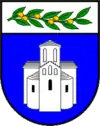Gračac
Gračac (pronounced [grǎtʃats] (![]() listen) is a municipality in the southern part of Lika, Croatia. The municipality is administratively part of Zadar County.
listen) is a municipality in the southern part of Lika, Croatia. The municipality is administratively part of Zadar County.
Gračac
| |
|---|---|
| Municipality of Gračac Općina Gračac Општина Грачац | |
 Gračac | |
| Coordinates: 44.299°N 15.847°E | |
| Government | |
| • Municipal mayor | Nataša Turbić (HDZ) |
| Area | |
| • Total | 957.22 km2 (369.58 sq mi) |
| Population (2011) | |
| • Total | 4,690 |
| • Density | 4.9/km2 (13/sq mi) |
| Postal code | 23 440 |
| Area code(s) | +385(0)23 |
| Vehicle registration | ZD |
| Website | www |
Gračac is located south of Udbina, northeast of Obrovac, northwest of Knin and southeast of Gospić.
Settlements
The total municipality population is 4,690 (census 2011), in the following settlements:[3]
- Begluci, population 61
- Brotnja, population 47
- Bruvno, population 92
- Cerovac, population 3
- Dabašnica, population 3
- Deringaj, population 77
- Donja Suvaja, population 53
- Drenovac Osredački, population 12
- Duboki Dol, population 0
- Dugopolje, population 20
- Glogovo, population 11
- Gornja Suvaja, population 36
- Grab, population 78
- Gračac, population 3,063
- Gubavčevo Polje, population 3
- Kaldrma, population 31
- Kijani, population 56
- Kom, population 34
- Kunovac Kupirovački, population 37
- Kupirovo, population 46
- Mazin, population 47
- Nadvrelo, population 1
- Neteka, population 87
- Omsica, population 12
- Osredci, population 42
- Otrić, population 15
- Palanka, population 19
- Pribudić, population 5
- Prljevo, population 7
- Rastičevo, population 4
- Rudopolje Bruvanjsko, population 31
- Srb, population 472
- Tiškovac Lički, population 15
- Tomingaj, population 26
- Velika Popina, population 71
- Vučipolje, population 1
- Zaklopac, population 23
- Zrmanja, population 21
- Zrmanja Vrelo, population 28
History
Gračac was ruled by Ottoman Empire between 1527 and 1687 (nominally to 1699) as part of the Sanjak of Lika in the Bosnia Eyalet before Austrian conquest. The 1712–14 census of Lika and Krbava registered 1,711 inhabitants, out of whom 1,655 were Vlachs, 53 were Catholic Bunjevci and 3 were Catholic Croats.[4][5] In the late 19th century and early 20th century, Gračac was part of the Lika-Krbava County of the Kingdom of Serbia-Croatia and Slovenia.
The area of Gračac was not part of the Austro-Hungarian crown land of Dalmatia, but it is often perceived as part of Dalmatia in the modern sense because of its inclusion in Zadar County.
Demographics
| Population by ethnicity | ||||
|---|---|---|---|---|
| Year of census | total | Croats | Serbs | Others |
| 1961 | 17,586 | 3,736 (21.24%) | 13,670 (77.73%) | 180 (1.02%) |
| 1971 | 14,819 | 3,107 (20.97%) | 11,318 (76.37%) | 394 (2.66%) |
| 1981 | 11,863 | 2,150 (18.12%) | 8,578 (72.31%) | 1135 (9.57%) |
| 1991 | 10,434 | 1,697 (16.26%) | 8,371 (80.22%) | 366 (3.51%) |
| 2001 | 3,923 | 2,260 (57.61%) | 1,523 (38.82%) | 140 (3.57%) |
| 2011 | 4,690 | 2,528 (53.90%) | 2,118 (45.16%) | 44 (0.94%) |
Note: in some censa, parts of the population listed themselves as Yugoslavs instead of Serb or Croat.
Attractions
The name Gračac is derived from "gradina" which means an old abandoned castle. Near the town there are Lake Štikada and the karst field of Gračac. The Cerovac caves nearby are open for tourists. The town is on the way into the Lika region of Zadar county, and the surroundings offer good hunting game.
See also
References
- Government of Croatia (October 2013). "Peto izvješće Republike Hrvatske o primjeni Europske povelje o regionalnim ili manjinskim jezicima" (PDF) (in Croatian). Council of Europe. p. 36. Retrieved 30 November 2016.
- "Općine na područjima posebne državne skrbi Republike Hrvatske" (PDF). Croatian Chamber of Economy. Retrieved 15 April 2020.
- "Population by Age and Sex, by Settlements, 2011 Census: Gračac". Census of Population, Households and Dwellings 2011. Zagreb: Croatian Bureau of Statistics. December 2012.
- Šarić, Marko (2009). "Predmoderne etnije u Lici i Krbavi prema popisu iz 1712./14.". In Željko Holjevac (ed.). Identitet Like: Korijeni i razvitak (PDF) (in Croatian). 1. Zagreb: Institut društvenih znanosti Ivo Pilar. p. 375. ISBN 978-953-6666-65-2. Archived from the original (PDF) on 2015-09-24. Retrieved 2018-02-26.
- http://www.skdprosvjeta.com/pdf/9.pdf Karl Kaser, POPIS LIKE I KRBAVE 1712. GODINE, (prijevod s njemačkog: Sanja Lazanin), 2003. #page=19
External links
| Wikimedia Commons has media related to Gračac. |
